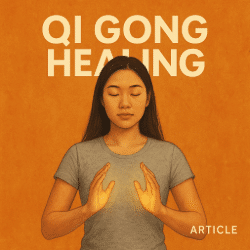Introduction: Healing Starts With Stillness
In a world driven by constant stimulation, the body’s natural rhythm often falls out of step with wellness. Fatigue lingers, emotions run high, and chronic discomfort becomes normalized. Yet, hidden in plain sight lies a tradition that doesn’t demand exertion or medication, but presence: Qi Gong healing. This ancient Chinese practice blends breath, movement, and awareness to stimulate the body’s own capacity to repair and regulate itself. Grounded in both tradition and growing scientific attention, Qi Gong offers a path to healing that is quiet, sustainable, and transformative.
Historical Roots of Qi Gong Healing
Qi Gong (also spelled Qigong) is not a single system but a vast field of energy-based practices developed over more than 4,000 years. Historically, it arose at the intersection of Taoist philosophy, Chinese medicine, martial arts, and Buddhist meditation. Early records from the Mawangdui Silk Texts (circa 168 BCE) depict figures practicing Daoyin, a proto-Qi Gong form used to treat disease by balancing internal energy (Lo, 2005).
By the Han Dynasty, physicians were prescribing Qi Gong to regulate the five organ systems and balance the vital substances: Qi (life energy), Blood, Essence, Shen (spirit), and Body Fluids. Manuals like the Huangdi Neijing positioned Qi regulation at the heart of preventive and curative medicine (Veith, 2002). Taoist monasteries, especially those on Mount Wudang, became centers of healing through energy cultivation.
Later, during the Ming and Qing Dynasties, laypeople increasingly turned to Qi Gong not just for spiritual progress or martial strength, but for managing fatigue, stress, and illness. Its applications ranged from recovery after epidemics to treating internal injuries. In modern times, Qi Gong became part of China’s national health policy, particularly after the Cultural Revolution when scientific studies began validating its physiological effects (Jahnke et al., 2010).
What Is Qi Gong Healing?
At its core, Qi Gong healing is the intentional use of movement, breath, and mental focus to stimulate, circulate, and balance the body’s internal energy, or Qi. According to Traditional Chinese Medicine (TCM), illness and discomfort arise when Qi is blocked, weak, or chaotic. Qi Gong acts as both prevention and remedy.
Unlike external treatments, Qi Gong works from the inside out. Gentle exercises guide Qi along meridian pathways, releasing stagnation and encouraging the flow needed for tissue repair, organ function, and emotional regulation. Some practices are dynamic (moving forms), while others are meditative or even performed lying down.
Qi Gong healing is not symptom-chasing. It addresses root causes: stress, poor circulation, emotional suppression, and energy depletion. Healing unfolds as the body re-learns how to regulate itself.
Key Benefits of Qi Gong Healing
1. Emotional Regulation
Qi Gong downregulates the sympathetic nervous system (fight-or-flight) and activates the parasympathetic state (rest-and-digest). Breathing techniques calm the mind and enhance the flow of Shen, the spirit housed in the heart. This reduces anxiety, irritability, and emotional numbness (Liu et al., 2021).
2. Chronic Pain Relief
Studies show that consistent Qi Gong practice can reduce musculoskeletal pain, joint stiffness, and fibromyalgia symptoms (Lee et al., 2020). Movement and breath increase blood flow, improve posture, and relax muscle tension.
3. Immune and Organ Support
Qi Gong has been shown to modulate immune markers such as NK cell activity and cytokine levels. Practices targeting the Lung and Spleen meridians can enhance detoxification and nutrient assimilation (Jahnke et al., 2010).
4. Energy Recovery
Unlike aerobic exercise, Qi Gong nourishes rather than depletes. It supports adrenal recovery and replenishes Jing (Essence), a vital reserve often taxed by stress, overwork, and aging.
5. Mental Clarity and Sleep
Meditative Qi Gong increases alpha and theta brainwave activity. Practitioners often report deeper sleep, fewer intrusive thoughts, and greater clarity during the day.
How to Practice Qi Gong for Healing
1. Choose a Focus
Start with a clear intention: pain relief, emotional healing, or general balance. Qi follows intent.
2. Practice Daily
Short daily sessions (10–20 minutes) are more effective than sporadic, longer ones. Consistency builds the energy field.
3. Include the Three Components
Breath: Slow, abdominal breathing to activate the parasympathetic system.
Movement: Gentle, flowing movements (e.g., Baduanjin, Five Animal Frolics).
Awareness: Mental focus on sensation, breath, or visualization (light, warmth, water).
4. Rest After Practice
This allows Qi to settle. Lie quietly or sit in stillness to absorb the effects.
5. Learn Safely
Find a reputable instructor or online source familiar with therapeutic Qi Gong. Medical Qi Gong is a specialized branch that addresses clinical conditions.
Is Qi Gong Healing Safe for Everyone?
Yes, with a few exceptions. Qi Gong is generally safe for all ages and fitness levels. It’s non-invasive and low-impact. However, individuals with psychiatric conditions, acute infections, or complex trauma should consult a qualified practitioner.
Unlike pharmacological treatments, Qi Gong has minimal side effects. Occasionally, beginners may experience a brief release of old emotional or physical tension, a sign of Qi regulation.
Western Research on Qi Gong Healing
Modern studies increasingly validate what ancient practitioners observed. Research from journals like Frontiers in Psychology, The Journal of Alternative and Complementary Medicine, and Evidence-Based Complementary and Alternative Medicine confirm benefits in the areas of:
Qi Gong is even being explored in oncology settings, with patients reporting less fatigue, better appetite, and improved emotional outlook.
Integrating Qi Gong Healing Into a Modern Lifestyle
Morning Routine: Start your day with breath and gentle movement to open meridians.
Midday Reset: Use a short seated practice to shift from mental fatigue to clarity.
Evening Wind-Down: Apply slow Qi Gong walking or breathing to aid digestion and sleep.
Integrating these moments into daily life reframes healing as an ongoing state, not a crisis response.


